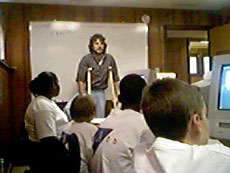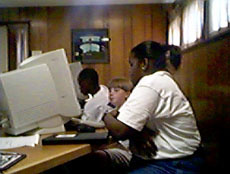|
July 18, 1997 The Internet Explorers Club, for the year, officially ended as of 4:30 this afternoon when the final session of the club left the Foundation to head back into the world with a new found knowledge. Still, the day was eventful with students taking advantage of the opportunity to talk with real scientists, investigate revolutionary mathematics, and work once more with computer modeling. Even as students left the building, many knew that they would be returning to take advantage of other Shodor programs or work as interns for the Foundation. As usual, the day started off with an introduction and recap by Joe South, the Course Director for SUCCEED's IEC program. Although many of the students had never used the Internet before coming to the Foundation, they were all leaving with at least an idea of how to use it advantageously. Students now know and understood bookmarking, e-mailing, search engines, computational modeling, on-line collaborative tools, and chatting. They have also come to grasp the importance of observation and the necessity of careful reasoning to avoid jumping to conclusions. All in all, the week was a tour de force of modern computer knowledge.
This review soon gave way to the day's first important event; a chat session with real scientists from around the world. This chat session, moderated by Shodor intern Anne Thissen, allowed the students to ask real questions about a variety of modern scientific issues. This chat session, which occupied over an hour of the students' time, was one of the major highlights of the afternoon's events. Next the students went outside for group pictures. The students, mostly cooperative, quickly completed their first serious picture. Then, the fun began as students took Shodor intern Tom Dietz's next request seriously: "Everybody line up against the wall!" Students posed as if they were on a police video. This completed, the students returned inside to finish the model begun by Shodor intern Andy Hebrank on the previous day. Since this group alone of the IEC sessions had found all the information they needed the day before, they were able to immediately begin the Ebola model upon returning inside. The model, designed by Andy himself (with fellow intern Jonathan Pahl), was a 'qualitative' look at the relationship between certain aspects of a closed system containing the Ebola virus. Andy, elaborating upon this idea, stated: "This is a qualitative model--not a quantitative one...A qualitative model only gives a good idea of what is going on. A quantitative model actually give a good realistic guess as to what is happening based on the data assembled." With this in mind, the students looked at the model with great curiosity. Andy went over the graphs and worked with the students to give them a good understanding of the relationship between the model and reality. The students, seemingly satisfied, were ready to begin their final scientific exploration. Mike South, a mathematician at the Foundation, provided students with an introduction to fractals. The students were introduced to the inner workings of Snowflake Online, a program developed by Mike South for the foundation. The students worked through the Snowflake program, and fractals as a whole, by first investigating the concept on sheets of graph paper. Once the students had gotten a good idea of what they were doing, they moved on to using the application itself. The students toyed with the application freely, increasing the number of iterations each time in order to better understand why the end result looked as it does. The farewell from the program, though not particularly sad, had many of the students leaving with an interest in both science and the possibility of returning to the Foundation for more informative instruction. But regardless of the intentions of any particular students leaving the door, all had new skills and knowledge that have made them better thinkers and computer-users, and most knew, understood, and appreciated this. The SUCCEED program as a whole has been a success, and hopefully in the years to come will continue to breed new opportunities for a variety of young computer users who may have a basic understanding of science and the Internet but hope to do more with this knowledge.
Last Update: June 14, 1999 Please direct questions and comments about this page to WebMaster@shodor.org © Copyright 1998 The Shodor Education Foundation, Inc. |



